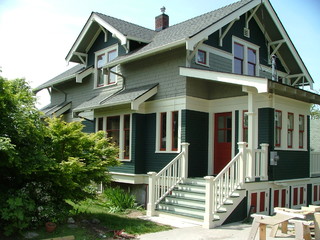Because I live in an older neighborhood with no homeowners association or bylaws, there are no rules and regulations that dictate exterior paint colors. Most of the time, that's a very good thing. Recently, however, our neighbors painted their home a shade of green that ... well, let's just say it's gotten a lot of stares, and not the flattering kind.
Unlike interior colors, exterior hues can affect the entire street — and that puts a lot of pressure on homeowners when it comes to choosing a palette. In addition, a number of factors come into play that you don't have to deal with on the inside of a house: landscaping, hardscaping, roofing and more.
Follow these tips to choose a color scheme that works both for your style and for your home's surroundings.
Plan around the elements that are hardest to change. Unless you're doing a complete renovation, surfaces such as roof shingles or tiles, stonework, pathways and driveways will remain in place. Take these into consideration as you select exterior colors.
Look for undertones between them that might inform your palette. Are they warm (beige, khaki, brown and rust) or cool (gray, blue and black)? Consider paint colors that will tie these fixed elements together in a harmonious way.
Consider your home's architectural style and era.Whether you have a Queen Anne Victorian, a Craftsman bungalow or a midcentury modern ranch, your exterior paint scheme should feel appropriate to the style. Imagine a classic federal-style home painted burnt orange, or a New England saltbox in pale mint green. Jarring, right?
Many paint manufacturers offer collections of historically accurate colors, which can be an excellent springboard for your palette, and you can also consult a professional who specializes in this area. You don't have to adhere strictly to historical guidelines unless codes for your home and neighborhood specify otherwise, but for the most pleasing effect, don't stray too far from them.
Think about the visual effect you want. Mull over your home's relationship to the street and the landscape. Does it sit back from the road or amid a cluster of large, towering trees? You might choose a slightly lighter or brighter color so that it stands out. Conversely, a darker hue can make it appear to recede.
Choose three or more different paint shades. Essentially, an exterior scheme has three major parts: field color, which dominates; accent color, which brings doors, shutters and other smaller areas to life; and trim color, used for window and door casings, roof edging, railings and other trimwork.
Ideally, the trim color should contrast strongly with the field color. If your main hue is dark, consider classic white trim or another pale shade. A light field color can look stunning with darker trim — like eyeliner for your home, it produces a crisp, dramatic effect. Feel free to go bold with accent colors, but don't go overboard. A door painted bright red or lemon yellow lends just the right hit of punch. Extending that same shade to the shutters and gables ... not so much.
Stuck for inspiration? Most major paint brands offer preselected color palettes that take the guesswork out of coordinating an exterior scheme. An architect or a color consultant also can help you come up with a combination that's unusual but still attractive.
Never rely on paint chips alone. Just like interior colors, exterior shades can vary significantly from the way they appear on the chip. And because painting an exterior is a bigger undertaking than simply painting a room, you'll want to get them right the first time.
Buy a quart of paint and test it on an inconspicuous area of your home. Study it at various times of day and under different weather conditions. How does it change with the light? Road testing it is the only way to determine for sure if you'll be happy with it for years to come.
-Author: Lisa Federick via https://www.houzz.com/ideabooks/3317364/list/5-easy-tips-for-choosing-your-exterior-paint-palette






